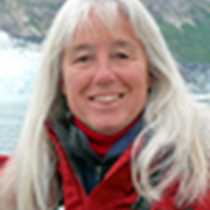National Geographic Sea Lion cruised south from Juneau overnight and entered Endicott Arm this morning. Sumdum Glacier tumbles down the steep mountain near the entrance to the fjord. The sun was shining and wisps of low clouds played through the stunning scenery. Marbled murrelets dotted the surface between dives for small fish. Surrounded by pristine wilderness, glassy water reflected mountains, forest and icebergs that had floated down from Dawes Glacier, still miles ahead. One iceberg supported several harbor seals, providing an additional photo opportunity. Earlier this season seals gave birth to their pups on icebergs in front of the glacier, protected from land predators and marauding killer whales.
Perusing the shoreline we spied two wolves chasing back and forth in front of a large rock at the mouth of a stream. We followed them with our binoculars as they trotted down the beach and back into the tall grass. Many bald eagles, young and older, also occupied this area. This was a very special and exciting wildlife sighting—a great way to start the day.
We filled the rest of the morning with naturalist staff introductions, important briefings, more scenery-viewing, and a photography presentation by photo instructor Mike. At last, the Dawes Glacier came into view at the head of the inlet, flowing from the mountains in Canada all the way to the sea. It once carved and completely filled the channel and is now receding back toward the Stikine Ice Field from which it came. Precipitous walls of rock bound the fjord on both sides and soar straight up toward the sky. Fed by melting snow and ice, myriad cascades course their way down to sea level.
After lunch we boarded our inflatable boats and positioned ourselves at a safe distance in front of the glacier to experience “White Thunder” as large chunks of ice broke off the face and crashed into the water with a great splash and loud roar. We were thrilled when a large piece broke off from below and surged to the surface. These are called “shooters.” The brash ice around us sizzled as pressurized air bubbles popped—ice crispies. The sun competed with a cold katabatic wind blowing down the glacier toward us. We were prepared for both with layers of warm clothes and sunscreen. It was fun to see harbor porpoises amongst the ice, and we had a surprise visit from the ship’s crew with a special delivery of warm drinks.
When we returned, Stephanie thought it would be a good time and place for a “Polar Plunge.” Several intrepid guests jumped into the frigid water, just for the fun of it.
Sea Lion turned and we started to make our way back down the channel. We continued to marvel at the scenery from the outside decks until it was time to come in for recap and dinner.
But the day was not over yet. Stephanie interrupted dessert when we intercepted some killer whales! It was breathtaking to see the tall black fins of an adult male slice through the water and rise six feet as the animal came to the surface. The color in the sky as the sun set was truly amazing. We had some exciting drama when a Dall’s porpoise showed up and one of the whales started to chase it. We saw small splashes as the porpoise zigged and zagged to try and escape. The whale repeatedly leapt into the air but finally gave up the chase and returned to join the pod, to the relief of the porpoise. This activity answered our question about whether these were “residents” or “transients”—residents eat mostly fish; transients eat other marine mammals.
It was a full, beautiful and exhilarating day. Mike described it as “Funtastic!”







